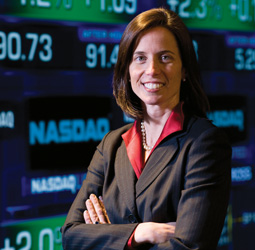The 1995 conference sponsored by the Owen School’s Financial Markets Research Center is one that Adena Testa Friedman will not soon forget. Just two years removed from graduation, she was back on campus watching Bill Christie, a favorite professor of hers, endure a searing critique from his former mentor Merton Miller, a Nobel laureate in economics. And as if that weren’t awkward enough, Friedman was actually rooting against Christie.
In 1995 Friedman was still a relatively new employee at NASDAQ, the nation’s largest electronic stock market. Meanwhile Miller had been hired as a consultant by NASDAQ to refute Christie’s theories about collusion among market makers at the company. (See sidebar.) While Friedman felt for her former professor, she quietly hoped that Miller—and NASDAQ—would prevail.
“I was rooting for the other guy,” she says, laughing. “But I thought at the same time that it must be so exciting and pretty intimidating for him to be facing this Nobel Prize winner. In the end Bill Christie was proven to be right. He literally fell across something important, and what he found ended up creating lasting change.”
While the history of the Owen School and the history of NASDAQ are forever linked because of Christie’s findings and the regulatory changes that followed, this is a story about Friedman, the company’s Executive Vice President for Corporate Strategy and Global Data Products—and soon-to-be Chief Financial Officer. When she assumes her new role in July, she will have been with NASDAQ for 16 years. Over that time she has taken the lead on a myriad of initiatives, including acquisitions and mergers that have positioned the company to compete in a changing global economy.
A Critical Thinker
Friedman started her NASDAQ career as a business analyst immediately after receiving her MBA from Owen. “I graduated saying I wanted to be a product manager, but not with commercial products. I wanted to manage complex products. I was lucky because that’s exactly what NASDAQ offered me,” Friedman says. One of her first tasks was to write the first product plan for the PORTAL system, which facilitates the quoting and trading of restricted securities eligible to be bought and sold by qualified buyers and sellers.
I graduated saying I wanted to be a product manager, but not with commercial products. I wanted to manage complex products. I was lucky because that’s exactly what NASDAQ offered me.
~ Adena Friedman
“When I came to NASDAQ, they didn’t understand that they had products. I came in on the ground level, building business plans for trading products. We had launched the initiative for PORTAL three years before but hadn’t succeeded in generating any revenue. We had to ask ourselves how to turn it around and make money off of it,” she says. That product plan, which involved instituting a fee, is still in place today.
Friedman initially didn’t see herself pursuing a career in finance, although her father was a managing director of T. Rowe Price Associates in Baltimore. Her mother was an attorney with a Baltimore firm. Friedman majored in political science at Williams College with a minor in Soviet studies.
During a monthlong stint at a language studies program in Russia, she was appalled to discover not only the dismal living standards of ordinary Russians but that she, a foreigner with U.S. dollars to spend, had access to superior goods and services.
A summer internship on Capitol Hill during her junior year was interesting, but she learned that life on the Hill was not for her. The year she graduated from Williams, 1991, was not a great one from the job market perspective, so she decided to go the direct route to graduate school.

“I wanted a more practical education, and I knew I wanted to go to business school,” she explains. While her future husband, Michael Friedman, JD’93, worked toward a law degree at Vanderbilt, she enrolled at the Owen School and immediately knew the teaching style was “perfect for my brain.”
“I only applied to Vanderbilt. I loved the fact that it was a small school with a small class size. And I absolutely loved the campus. I knew that straight out of college a great up-and-coming school was the better environment for me.
“I found that every class fitted with how I learned, how I understood things. I liked the teaching style,” she says. A marketing major with a secondary concentration in finance, she threw herself into her marketing case studies but found she also thrived in her finance classes.
After completing her first year at Owen, she was named a Dewey Daane Scholar. “I always remember the very brightest ones, and she was one of those, right at the top of her class,” says Daane, the Frank K. Houston Professor of Finance, Emeritus, who has taught monetary and fiscal policy at Owen for 34 years. Her papers are some of the very few he has sent to the Vanderbilt Archives.
Classmate Michelle DiPauli Kelly, MBA’93, remembers Friedman as “outgoing, gregarious, a joy to work with” and “a critical thinker but not a critical person.”
“When she had a point to make, she could make the point, even with lots of opposition, and do it well, and do it in the least offensive manner,” Kelly says. “She is very intelligent and also open to new ideas. In class she was always willing to listen and consider what others thought or what their views were. She was always good about asking the questions, ‘Why are we doing it? How can we do it better?’”
Managing and marketing complex products for NASDAQ perfectly melded the academic interests Friedman honed at Owen. “What I do falls under the marketing discipline. But what it really is, is being your own CEO of a product,” Friedman says.
Surpassing Expectations
After the successful relaunch of PORTAL in the mid-’90s, Friedman became involved in several dot-com initiatives for NASDAQ as well as sophisticated technological advances and acquisitions to handle the growing number of trades.
“By the time I got there, we were a very, very active market,” she says. “I remember we were building Workstation 2 and marketing that. We were trading around 100 million shares a day. We built the new workstation to handle 300 million trades, and within three days of the launch we were trading at that level. We just kept surpassing all expectations throughout the ’90s.”
The retooling that followed revelations of collusion among market makers in the early ’90s better positioned the company to thrive in a global economy, Friedman says. The company further reorganized in 2000, creating new business units and becoming a shareholder-owned, for-profit company.
“We looked at how we made our money and who our customers were,” Friedman explains. NASDAQ Data Products was formed, and Friedman ran that business unit as a senior vice president. As the company became more global, Friedman was primarily responsible for leading all mergers and acquisitions.
“We started by buying small electronic trading systems called Brut and INET. These acquisitions were critical to our survival,” she says, noting that the superior technology available through those electronic trading platforms vastly improved order routing and connectivity.
“It solidified our position in the U.S. market and allowed us to become a more profitable organization.” After those acquisitions the company began to look overseas.
A merger attempt with the London Stock Exchange in 2005 was unsuccessful, but Friedman believes that apparent failure turned out for the best: “They’re in a very different competitive situation now. We felt strongly we wouldn’t overpay, and we didn’t.”
Soon enough another international opportunity presented itself. In 2007 NASDAQ agreed to buy OMX, a Nordic and Baltic financial services company, which operated the Copenhagen, Stockholm and Helsinki stock exchanges, among others. The complicated transaction also involved the Borse Dubai, a stock exchange in the United Arab Emirates. The resulting merger, named NASDAQ OMX Group, is the world’s largest exchange company.
“The OMX/Dubai deal really showed Adena’s talent and mettle. The merger required a creative, complex solution,” says Anna Ewing, Executive Vice President and Chief Information Officer at NASDAQ OMX Group. “It required a marathon of 2 a.m. calls and all-night sessions during which I never saw Adena’s energy waiver nor her strong grasp and attention to detail fail.”
Since the merger NASDAQ OMX Group has acquired both the Philadelphia and Boston stock exchanges. Its growing global presence is astounding considering its humble origins. The National Association of Securities Dealers created NASDAQ in 1971 simply as a way to automate its quotation system. (NASDAQ was originally an acronym that stood for National Association of Securities Dealers Automated Quotations.)
“NASDAQ began as nothing more than a bulletin board on the computer for posting dealer quotes. The question that NASDAQ had to face was: How do you go from a quotation system to a real market? They made that transition fairly well and still provide services for independent dealers,” says Hans Stoll, Director of Owen’s Financial Markets Research Center and Anne Marie and Thomas B. Walker Professor of Finance. “Adena was very much involved in transforming a trade association into a business organization. Not only did Adena survive those changes, she was very much a part of them and she thrived.”
Riding Out the Downturn
In spite of the recent market meltdowns, NASDAQ OMX Group is faring remarkably well. In fact Forbes magazine recognized it as its “Company of the Year” in January 2009. The article cited the company’s ability to capitalize on opportunities in a tumultuous economic environment and mentioned the successful completion of recent acquisitions.
One benefit of the economic downturn has been the opportunity to focus on integration, or “having a moment to look at the landscape and look at new asset classes,” as Friedman says.
A recent initiative is a partnership with International Derivatives Clearing Group, a small company using NASDAQ technology to build a clearinghouse system for interest rate swaps. Combining the technology and the product in an organized fashion allows for more transparency, says Friedman, who oversaw the launch of that project as well.
With another project off the platform, Friedman continues to look toward the future: “We will continue to identify different opportunities to leverage our core strengths to find synergies and get into new businesses. That’s what I spend my time doing in addition to running the core products business.”
Colleagues say the atmosphere on Friedman’s team is “exhilarating.”
“Adena expects a ton from herself and her teams and, as a result, she brings the best out in everyone around her,” says Randall Hopkins, a senior vice president who works with Friedman in data products management. “She always stops to ask the second question about how you are,” Hopkins says. “Then, of course, she rightly launches into the challenge at hand. And she doesn’t miss a beat in doing so.”
One of the things that the strategy group does not do is write a three-year business plan. You always have to take into consideration the environment you’re in. That’s what’s great about it. Out of every crisis comes opportunity.
—Adena Friedman
Friedman believes transparency and flexibility are keys to riding out both upturns and downturns.
“One of the things that the strategy group does not do is write a three-year business plan. You always have to take into consideration the environment you’re in. That’s what’s great about it. Out of every crisis comes opportunity. We are well-positioned to capture some of those, particularly in organizing some OTC markets. We will continue to analyze what we think the role of markets are as we come out of these crises.”
Certainly transparency has become a key talking point at NASDAQ since the controversy surrounding embattled financier Bernie Madoff and his alleged Ponzi scheme has come to light. Madoff’s past history as non-executive Chairman of NASDAQ has been noted in the media, but Friedman points to the fact that his affiliation with the company ended years ago and he was never involved with daily operations. During the early ’90s the NASDAQ board operated in an advisory capacity to the NASD, before the NASD affiliation was dissolved.
The transparency that Bob Greifeld, CEO of NASDAQ OMX Group, and others have publicly called for would make the kind of “back office” deals that Madoff apparently engaged in more difficult to pull off. “When there’s no data, you don’t have a central way for the public to see what is going on. It makes it impossible for someone like Bill Christie to study those markets. Our view is that those need to be more organized,” says Friedman, who thinks a change in regulatory priorities should focus on “systemic risk.”
NASDAQ is banking on the fact that market innovations will continue to be not only profitable but also part of the solution. The company recently introduced a new government relief index tracking companies participating in programs such as TARP, the Troubled Assets Relief Program.
Meanwhile Friedman believes that the current economic situation has provided many valuable lessons for those joining the world of finance during difficult times.
“If you’re going into finance, don’t allow yourself to be swept away by the moment,” she says when asked how she would advise MBA graduates today. “Put all your actions in perspective. Look at the long-term health of your industry. A lot of the banks got swept away with the short-term returns. They were caught up in a level of competition that drove them to short-term thinking around whatever they were doing.”
Friedman says keeping the long-term health of the institution at the forefront is critical. “If you get swept away by a short-term current, you’re going to find yourself getting caught up in a bubble,” she says. “You always have to maintain your moral focus.”
In Friedman’s case, her moral focus begins at home. Married since 1993, she has two sons, Luke, 13, and Logan, 11, both of whom she credits with keeping her grounded. “The best thing is to go home at the end of the day and look at my kids and say, ‘That’s what’s important.’ Everything you’re doing is critical, but the real critical part is raising kids.”


Comments
5 responses to “Stock in Trade”
This is excellent! How did you learn this stuff when you were a newbie?
Although Vanderbuilt is a small school, would you not agree that the finance department at the school is among the top 20 in the country? They don’t have a bad sports program either!
Great post, I entirely agree that keeping long term strategy in mind is crucial, and short-term problems should be taken care , but must not influence the way we go.
Great post here, please keep the good work up. Thanks.
The downturn has been hard on everybody but we will break out of it.